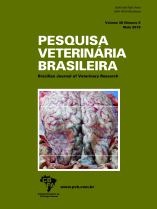 |
|
|
|
Year 2018 - Volume 38, Number 5
|

|
Intestinal lesions in pigs slaughtered in Rio Grande do Sul, Brazil, 38(5):823-831
|
ABSTRACT.- Pereira P.R., Caprioli R.A., Hammerschmitt M.E., Sonne L., Pavarini S.P. & Driemeier D. 2018. [Intestinal lesions in pigs slaughtered in Rio Grande do Sul, Brazil.] Lesões intestinais em suínos abatidos no Rio Grande do Sul. Pesquisa Veterinária Brasileira 38(5):823-831. Setor de Patologia Veterinária, Faculdade de Veterinária, Universidade Federal do Rio Grande do Sul, Av. Bento Gonçalves 9090, Prédio 42505, Porto Alegre, RS 91540-000, Brazil. E-mail: paula.rpereira@hotmail.com
Rio Grande do Sul stands out in the national swine industry due to high production rates, based on an intensive breeding system, which leads to the occurrence of enteric diseases. This study was performed to diagnose and determine the frequency of causes of bowel condemnation in the slaughter line. The samples of intestine and mesenteric lymph nodes were collected for histological and immunohistochemical analysis of a pig slaughterhouse located in the Vale do Taquari area, in Rio Grande do Sul (RS), which has Federal Meat Inspection Service (SIF). The collection occurred during 18 days in the summer (January and February) and 19 days during winter (June, July and August) of 2016. The pigs were from 55 different counties from of seven microregions of RS (microregion of Passo Fundo, Soledade, Guaporé, Santa Cruz do Sul, Lajeado-Estrela, Montenegro and São Jerônimo). Out of 2,523 condemned intestines in the summer and 2,747 in the winter, 216 and 199 were evaluated, respectively. The three main diagnoses were chronic serositis (43.1%), ascaridiosis (21.4%), and porcine proliferative enteropathy (20%), followed by cases of plug caseous in ileocecal valve (5.0%), intestinal abscess (1.0%), pneumatosis (1.0%), circovirosis (0.7%), oesophagostomiasis (0.7%), salmonellosis (0.7%) and a case of intussusception (0.2%). Chronic serositis was diagnosed in 82/216 (38%) in summer and 97/199 (48.7%) in winter, ascaridiosis had a higher occurrence in the summer with 64/216 (29.6%) compared to the winter when it was observed 25/199 (12.6%). Porcine proliferative enteropathy was diagnosed in 37/216 (17.1%) in summer and 46/199 (23.1%) in winter. |
| |
|
|
| |
|
 |